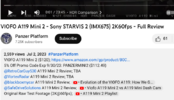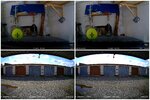Perfectly good place for it, I like going off topic!
It is true that the A139 Pro has PDAF (Phase Detection Array AutoFocus built into the sensor, but it is only the detection part of it - the PDAF sensor, there is no focusable lens. Since in a dashcam you want everything in focus all the time, a focusable lens would be useless! The sensor is there for cameras that do have autofocus.
I guess you could argue for a focusable lens to correct high temperature focus drift, but very often the temperature related problems can't actually be corrected by refocusing the lens since it is the individual elements within the lens that go out of focus rather than the whole lens.
The sensor does have lenses built in, the design of which is related to the PDAF, which may be causing some confusion, but these are not focusable lenses.
On the issue of the shroud, because of the very wide angle lens, the shroud would have to cover most of the windscreen to fully work, which would mean that the driver couldn't see! That is why we don't use them.






